Salesforce Bundle
How Does Salesforce Dominate the CRM Landscape?
Salesforce has redefined how businesses connect with their customers, becoming a powerhouse in the cloud-based software arena. Its innovative Software-as-a-Service (SaaS) model has consistently delivered impressive financial results, solidifying its market leadership. For example, in the first quarter of fiscal year 2025, Salesforce reported a total revenue of $9.13 billion, marking an 11% year-over-year increase, or 13% in constant currency.
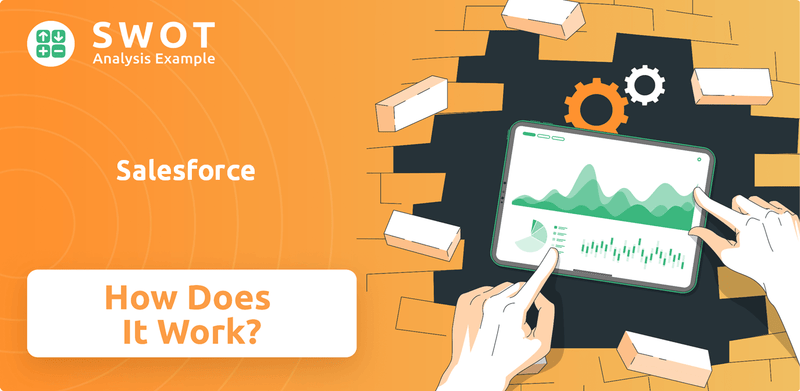
This in-depth analysis explores the core functions of the Salesforce SWOT Analysis, from its comprehensive suite of enterprise applications to its diverse revenue streams. Whether you're a seasoned investor, a business strategist, or simply curious about the future of cloud computing, understanding the Salesforce platform and its impact on customer relationship management (CRM) is essential. We'll examine how Salesforce features drive efficiency and foster stronger customer relationships, providing valuable insights into its business model and profit generation mechanisms.
What Are the Key Operations Driving Salesforce’s Success?
At its core, the company's operations are centered around its cloud-based CRM software, a centralized system designed to manage customer interactions and data. This platform offers a suite of integrated applications, including Sales Cloud, Service Cloud, and Marketing Cloud. These applications cater to a diverse clientele, ranging from small and medium-sized businesses to large enterprises across various sectors like financial services, healthcare, and retail. The company's primary focus is on providing a robust, scalable, and accessible CRM solution.
The operational processes are built on a multi-tenant cloud architecture, which ensures scalability and accessibility. The company consistently updates its platform with new features. Sales are mainly driven by a direct sales force, supported by a strong partner ecosystem. Customer service is provided through online support, training, and a global user community. The company's supply chain is digital, focusing on secure and reliable cloud infrastructure. The company's operational uniqueness stems from its customer-centric approach and a highly customizable platform, enabling businesses to tailor the CRM solution to their specific needs.
This adaptability, combined with continuous innovation, results in significant customer benefits, such as improved sales productivity, enhanced customer service, and more targeted marketing campaigns. This drives market differentiation, making the company a leader in the CRM software market. The company's commitment to customer success and platform customization sets it apart from competitors, providing businesses with a powerful tool to manage and optimize their customer relationships.
The Salesforce platform serves as the foundation for all its CRM solutions. It provides a comprehensive suite of tools and features designed to streamline and enhance various business processes. The platform's architecture supports a wide range of applications, including sales, service, and marketing automation. It also offers extensive customization options, allowing businesses to tailor the platform to their specific needs and workflows.
Key Salesforce features include robust sales force automation, customer service management, and marketing automation tools. These features are designed to improve sales productivity, enhance customer service, and optimize marketing campaigns. The platform also offers advanced analytics and reporting capabilities, enabling businesses to gain valuable insights into their customer data and business performance.
Sales Cloud features are designed to streamline the sales process, from lead generation to deal closure. It includes features like lead management, opportunity tracking, and sales forecasting. Sales Cloud helps sales teams manage their pipelines more effectively, improve their win rates, and increase overall sales productivity. It is a core component of the company's CRM offerings.
The Marketing Cloud benefits businesses by providing tools to create, manage, and optimize marketing campaigns. It includes features like email marketing, social media marketing, and marketing automation. The Marketing Cloud helps businesses engage with their customers more effectively, personalize their marketing messages, and drive higher conversion rates. It integrates seamlessly with other company's products.
The company's CRM software helps businesses manage all aspects of their customer interactions and data. This includes managing leads, tracking sales opportunities, providing customer service, and running marketing campaigns. The platform's integrated approach allows businesses to have a unified view of their customers and their interactions.
- Salesforce offers a single platform for all customer-related activities.
- Businesses can improve customer satisfaction and loyalty.
- The platform's scalability allows it to grow with a business.
- The platform's customization options allow businesses to tailor the system to their needs.
Salesforce SWOT Analysis
- Complete SWOT Breakdown
- Fully Customizable
- Editable in Excel & Word
- Professional Formatting
- Investor-Ready Format
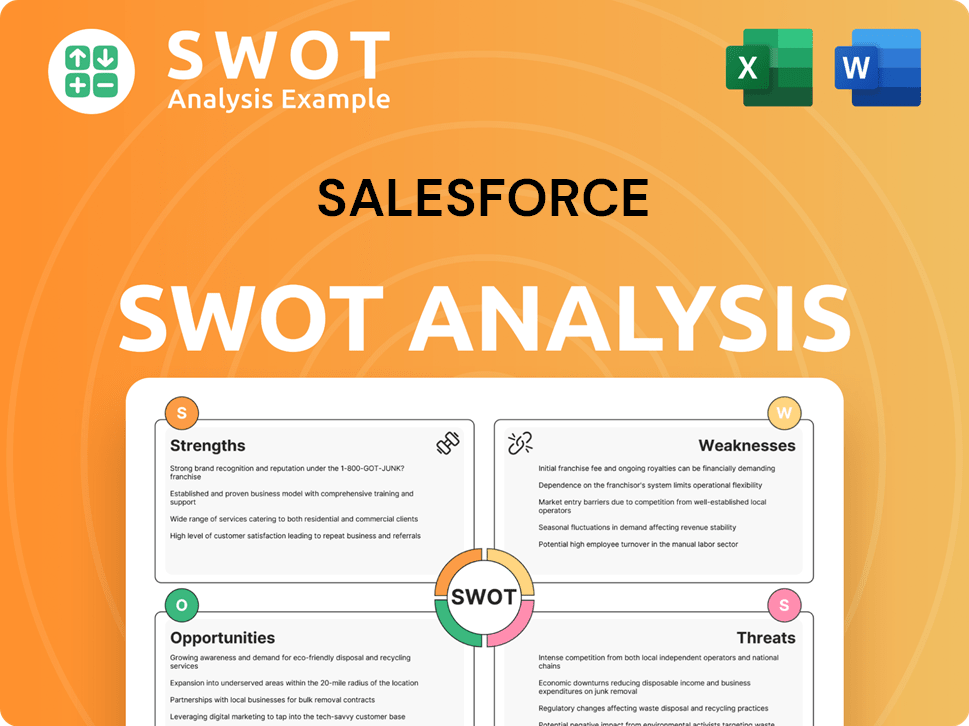
How Does Salesforce Make Money?
The primary revenue source for the company is subscriptions and support fees for its cloud-based services. This SaaS (Software as a Service) model is the backbone of its financial success. For the first quarter of fiscal year 2025, subscription and support revenues reached $8.59 billion, marking a 12% year-over-year increase, demonstrating consistent growth.
The company uses a variety of monetization strategies to maximize revenue. These include tiered pricing models and cross-selling, enabling the company to cater to a wide range of customers, from small businesses to large enterprises. The company’s approach ensures it can meet diverse customer needs while driving revenue growth.
In addition to subscriptions, the company generates revenue from professional services, such as implementation, training, and consulting. This segment contributed $0.54 billion in the first quarter of fiscal year 2025. The company has consistently expanded its product offerings and acquired companies to broaden its portfolio, thereby increasing potential revenue streams.
The majority of revenue comes from subscriptions and support fees. This revenue stream is driven by recurring contracts for access to its various cloud products and customer support. The company's subscription model ensures a steady income stream.
The company uses tiered pricing to cater to different customer needs. This approach allows the company to serve a broad spectrum of businesses, from startups to large corporations. Different tiers offer varying levels of features and functionality.
Cross-selling and up-selling are key strategies for increasing revenue. The company encourages existing customers to adopt additional cloud services or upgrade their subscriptions. An example is encouraging Sales Cloud users to integrate Service Cloud.
Professional services, including implementation, training, and consulting, contribute to revenue. This segment provides additional revenue streams and enhances customer relationships. Professional services are a valuable part of the business model.
The company consistently expands its product offerings and acquires companies. This strategy broadens its portfolio and increases potential revenue streams. This expansion solidifies the company’s position as a comprehensive enterprise solution provider.
The company's focus on cloud computing is central to its revenue model. Its cloud-based services offer flexibility and scalability. The company's cloud-based approach drives its financial success.
The company's revenue streams and monetization strategies are designed to maximize profitability and customer value. The company's focus on Growth Strategy of Salesforce, cloud computing, and customer relationship management (CRM) software has positioned it as a leader in the industry. The company's ability to offer comprehensive solutions and adapt to market changes ensures its continued success. The company's features, including Sales Cloud, Service Cloud, and Marketing Cloud, are designed to meet the diverse needs of its customers. The company's success is also reflected in its ability to provide excellent customer service and maintain strong data security. The company's various pricing plans and integration capabilities further enhance its value proposition.
The company's revenue is primarily driven by subscriptions, professional services, and strategic acquisitions. These elements work together to create a robust and scalable business model.
- Subscriptions: Recurring revenue from cloud-based services.
- Professional Services: Implementation, training, and consulting.
- Product Expansion: Broadening the portfolio through acquisitions and new offerings.
- Customer Retention: Focus on customer success and long-term relationships.
- Market Leadership: Strong position in the CRM and cloud computing markets.
Salesforce PESTLE Analysis
- Covers All 6 PESTLE Categories
- No Research Needed – Save Hours of Work
- Built by Experts, Trusted by Consultants
- Instant Download, Ready to Use
- 100% Editable, Fully Customizable
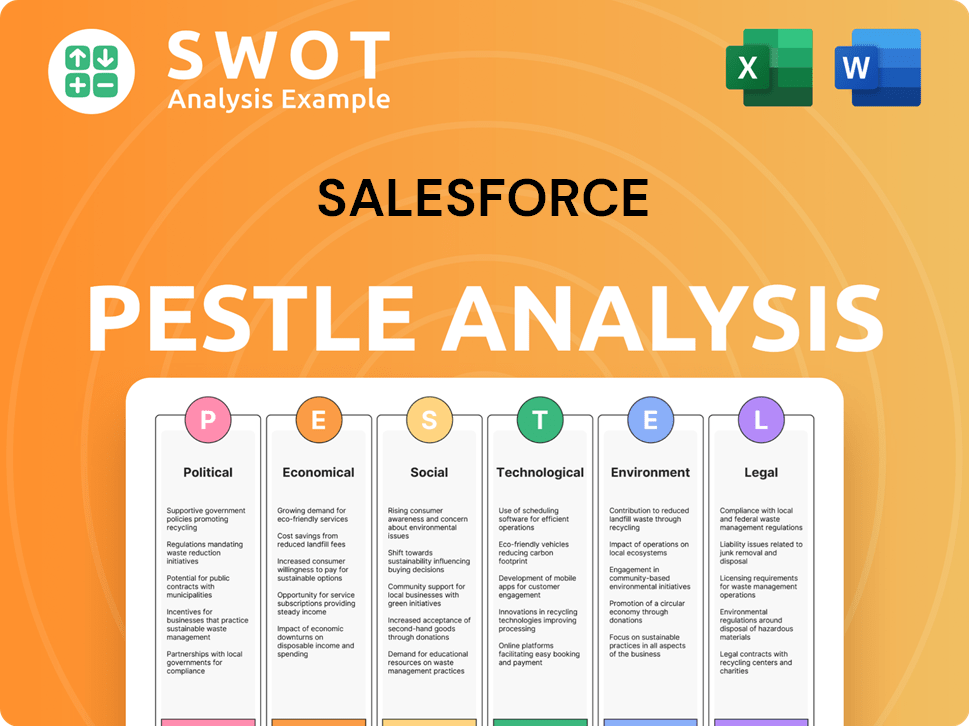
Which Strategic Decisions Have Shaped Salesforce’s Business Model?
The journey of Salesforce has been marked by significant milestones and strategic maneuvers that have shaped its operations and financial performance. A pivotal moment was its early embrace of the cloud computing model, which allowed it to disrupt the traditional on-premise software market. Key product launches, such as the initial release of Sales Cloud and subsequent expansions into Service Cloud and Marketing Cloud, have steadily broadened its market reach and solidified its comprehensive CRM offering.
Strategic acquisitions have also played a crucial role. For instance, the acquisition of Slack in 2021 for $27.7 billion significantly expanded Salesforce's collaboration capabilities, integrating communication directly into its platform. Another notable acquisition was Tableau in 2019, bolstering its analytics offerings, which is a crucial aspect of Salesforce features. Operational challenges, such as integrating diverse acquired technologies and maintaining rapid innovation while scaling, have been met with continuous investment in R&D and platform development.
Salesforce's competitive advantages are multifaceted. Its strong brand recognition and extensive global customer base provide significant brand strength. Technology leadership, particularly in AI with initiatives like Einstein Copilot, offers a competitive edge by embedding intelligent capabilities across its platform. The company benefits from network effects and a robust ecosystem of partners and developers building on its platform, creating a sticky and expanding environment for customers. Salesforce continues to adapt to new trends, such as the increasing demand for AI-powered solutions and industry-specific clouds, by investing in these areas to maintain its leadership position and address evolving customer needs.
Salesforce's early adoption of cloud computing was a game-changer, allowing it to disrupt the traditional software market. The launch of Sales Cloud, followed by Service Cloud and Marketing Cloud, broadened its market reach. The acquisition of Slack for $27.7 billion in 2021 expanded its collaboration capabilities, while the purchase of Tableau in 2019 strengthened its analytics offerings.
Acquisitions have been a key part of Salesforce's strategy, with Slack and Tableau being prime examples. Investment in research and development and platform development has been continuous to address operational challenges. The company is constantly adapting to new trends, such as the increasing demand for AI-powered solutions and industry-specific clouds.
Salesforce's strong brand recognition and large customer base provide a significant advantage. Its technology leadership, especially in AI with Einstein Copilot, offers a competitive edge. The company benefits from network effects and a robust ecosystem of partners. This creates a sticky and expanding environment for customers, making it a strong player in the CRM software market.
In fiscal year 2024, Salesforce reported revenue of over $34.86 billion, a 11% increase year-over-year. Subscription and support revenues were approximately $32.55 billion. The company's focus on cloud computing and customer relationship management has driven significant growth.
Salesforce maintains a strong position in the CRM market, driven by its comprehensive platform and strategic acquisitions. The company's strategy involves continuous innovation, particularly in AI, and expansion into new markets. Salesforce's commitment to customer success and its robust partner ecosystem further solidify its market leadership.
- Focus on Cloud Computing: Salesforce's early adoption of cloud technology gave it a significant advantage.
- Strategic Acquisitions: The acquisitions of Slack and Tableau broadened its capabilities and market reach.
- AI Integration: Initiatives like Einstein Copilot enhance the platform's intelligence and user experience.
- Customer-Centric Approach: Salesforce prioritizes customer success and provides extensive support.
Salesforce Business Model Canvas
- Complete 9-Block Business Model Canvas
- Effortlessly Communicate Your Business Strategy
- Investor-Ready BMC Format
- 100% Editable and Customizable
- Clear and Structured Layout
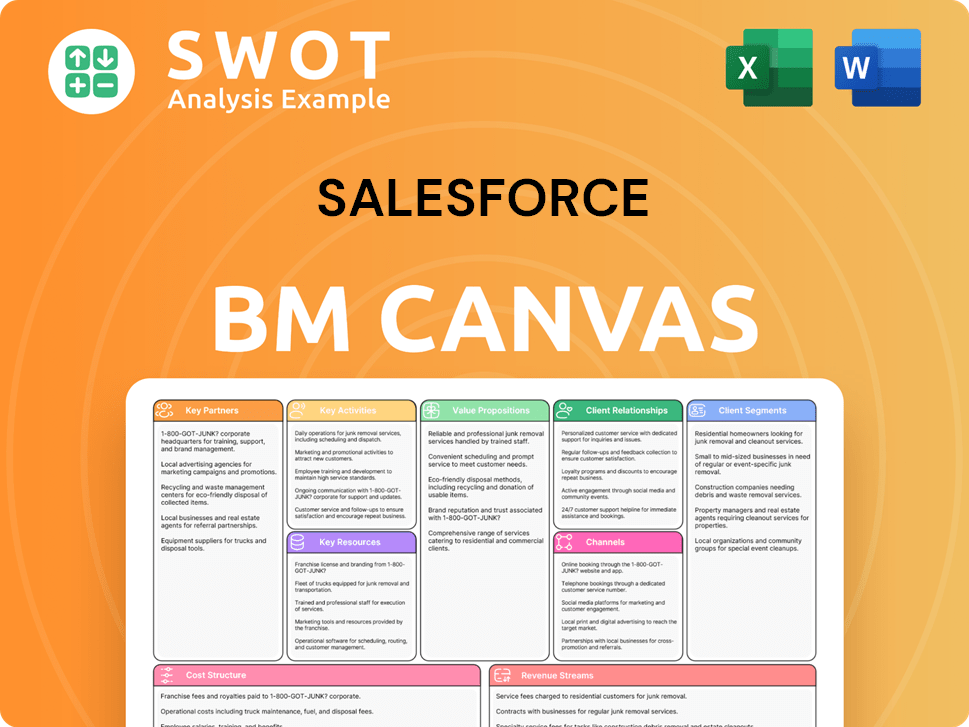
How Is Salesforce Positioning Itself for Continued Success?
Salesforce holds a prominent position in the Customer Relationship Management (CRM) market. It is recognized as a leader with a substantial market share. The company's global reach is extensive, serving businesses across various industries and geographies. However, several key risks could impact its operations and revenue.
Salesforce's future outlook involves strategic initiatives to mitigate risks and drive growth. Its innovation roadmap emphasizes AI integration across its product suite. The company is also focused on expanding its industry-specific cloud solutions. Its plans include continued innovation, leveraging AI, and expanding its presence in emerging markets.
Salesforce is a leading provider of CRM software, consistently ranked as a market leader. It boasts a significant market share, often outpacing competitors due to its comprehensive platform and strong customer loyalty. The company serves a diverse range of industries and has a global presence.
Key risks include intense competition from established players and emerging SaaS providers. Regulatory changes, particularly concerning data privacy and security, pose challenges. Technological disruption and economic downturns could also impact enterprise spending on software.
Salesforce plans to sustain growth by innovating its core CRM offerings and leveraging AI. It aims to expand its presence in emerging markets and specialized industry verticals. The company focuses on customer success, platform innovation, and strategic acquisitions.
Salesforce is integrating AI across its product suite, exemplified by Einstein Copilot. It is expanding its industry-specific cloud solutions. Leadership emphasizes customer success, platform innovation, and strategic acquisitions.
In fiscal year 2024, Salesforce reported revenue of approximately $34.86 billion, a 10.9% increase year-over-year. The company's subscription and support revenue was $32.52 billion. Salesforce's focus on AI and industry-specific solutions is expected to drive future growth.
- Salesforce holds a significant market share in the CRM market, estimated at around 23.8% in 2023.
- The company's strategic investments in AI, such as Einstein Copilot, aim to enhance its product offerings and maintain its competitive edge.
- Salesforce continues to expand its cloud computing services, catering to diverse business needs.
- The company's customer base includes businesses of all sizes, from small businesses to large enterprises.
Salesforce Porter's Five Forces Analysis
- Covers All 5 Competitive Forces in Detail
- Structured for Consultants, Students, and Founders
- 100% Editable in Microsoft Word & Excel
- Instant Digital Download – Use Immediately
- Compatible with Mac & PC – Fully Unlocked
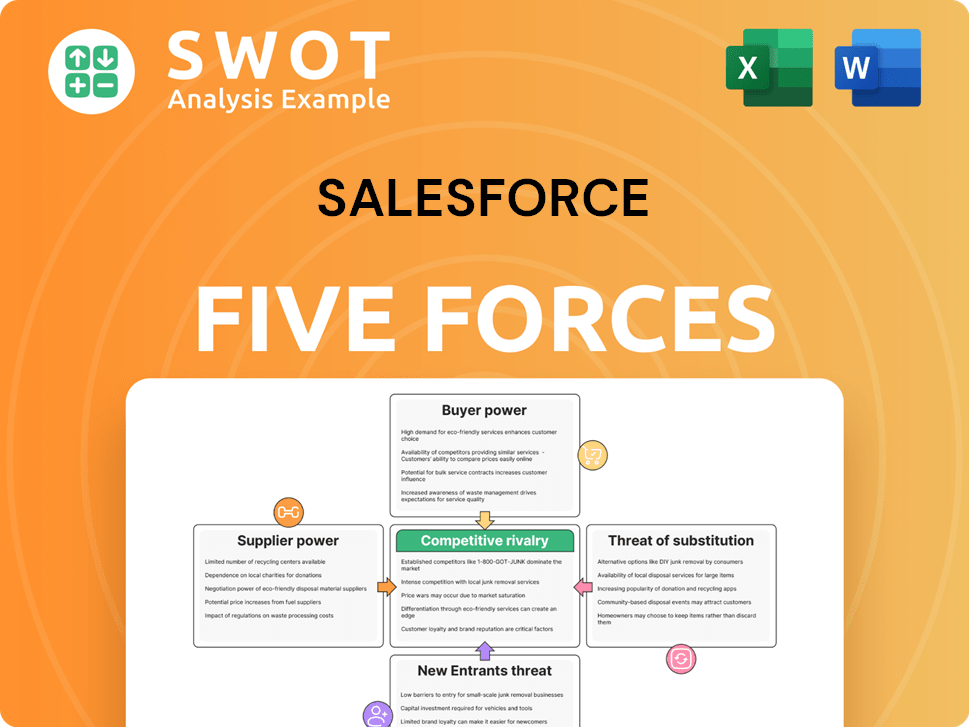
Related Blogs
- What are Mission Vision & Core Values of Salesforce Company?
- What is Competitive Landscape of Salesforce Company?
- What is Growth Strategy and Future Prospects of Salesforce Company?
- What is Sales and Marketing Strategy of Salesforce Company?
- What is Brief History of Salesforce Company?
- Who Owns Salesforce Company?
- What is Customer Demographics and Target Market of Salesforce Company?
Disclaimer
All information, articles, and product details provided on this website are for general informational and educational purposes only. We do not claim any ownership over, nor do we intend to infringe upon, any trademarks, copyrights, logos, brand names, or other intellectual property mentioned or depicted on this site. Such intellectual property remains the property of its respective owners, and any references here are made solely for identification or informational purposes, without implying any affiliation, endorsement, or partnership.
We make no representations or warranties, express or implied, regarding the accuracy, completeness, or suitability of any content or products presented. Nothing on this website should be construed as legal, tax, investment, financial, medical, or other professional advice. In addition, no part of this site—including articles or product references—constitutes a solicitation, recommendation, endorsement, advertisement, or offer to buy or sell any securities, franchises, or other financial instruments, particularly in jurisdictions where such activity would be unlawful.
All content is of a general nature and may not address the specific circumstances of any individual or entity. It is not a substitute for professional advice or services. Any actions you take based on the information provided here are strictly at your own risk. You accept full responsibility for any decisions or outcomes arising from your use of this website and agree to release us from any liability in connection with your use of, or reliance upon, the content or products found herein.